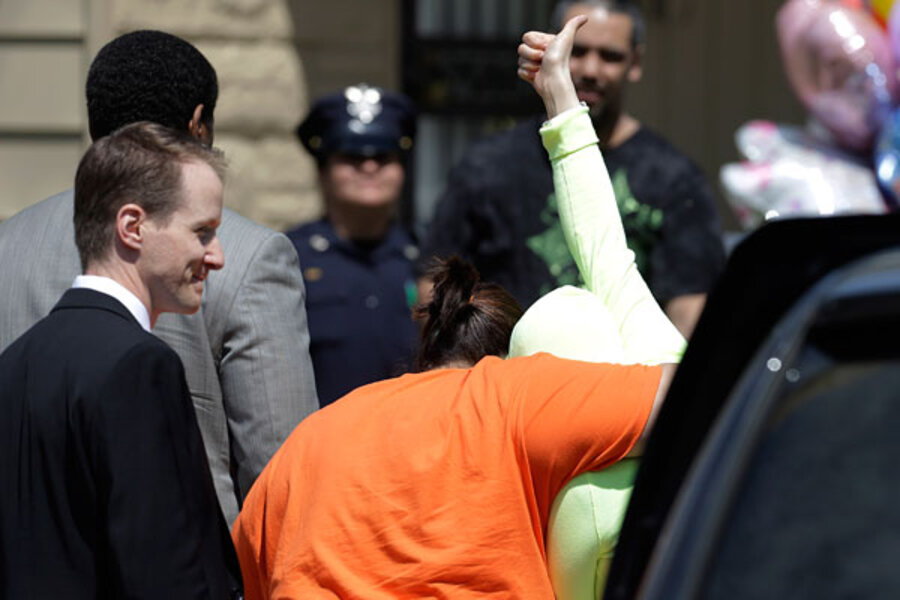Cleveland kidnapping: police hint at what three women's lives were like
Loading...
Cleveland prosecutors charged Ariel Castro with four counts of kidnapping and three counts of rape Wednesday while clearing his brothers, Pedro and Onil Castro, of any involvement in holding captive three women and one young girl for years.
The charges against Mr. Castro are all first degree felonies, and the suspect will be arraigned in court Thursday morning.
In a press conference Wednesday, city officials legal proceedings prevented them from discussing in detail many of the most pressing questions about the three women, such as how they were captured and what their lives were like in the house owned by Castro. But they did offer some new facts that begin to fill out the picture of a 10-year ordeal.
First, Cleveland Police Deputy Chief Ed Tomba said there was no evidence suggesting that Pedro and Onil Castro were involved. The three brothers were found together when police arrested Ariel Castro, and there was enough probable cause to take all three into custody Monday night, Mr. Tomba said. But neither will be charged in connection with the case. They remain in custody, but on outstanding warrants for misdemeanor crimes.
Tomba also said Monday night was the first opportunity in 10 years that the women had a chance to escape. In the house, the victims were kept in separate rooms, but they knew each other. They never left the property and went outside the house only twice during their captivity.
"We were told they left the house and went into the garage in disguise," he said.
Amanda Berry, Gina DeJesus, and Michelle Knight disappeared between 2002 and 2004. Ms. Berry escaped from the house Monday evening with the help of neighbors who heard her yelling and kicking the door, and called 911.
An FBI evidence recovery team removed more than 200 items from the house. Tomba said the agents described the house as being in “disarray.”
While Tomba and would not go into details about what happened to the victims while they were held captive due to the ongoing criminal prosecution, other officials confirmed details early Wednesday.
“We have confirmation that they were bound, and that there were chains and ropes found in the home,” Cleveland Police Chief Michael McGrath told NBC’s “Today” show Wednesday morning.
Public Safety Director Martin Flask said investigators have not confirmed how the ropes and chains were used. A cadaver dog did not find any human remains inside the house or on the property, he said.
It will take several weeks for the FBI to catalog and test the evidence. The victims’ testimonies are the main source of evidence for the charges, Tomba said. The suspect cooperated with the investigators, providing a detailed statement. The suspect was read his Miranda rights, and the police do not suspect him in additional abduction cases. Castro underwent a DNA test to determine if he is the father of the 6-year-old girl, who is Berry’s daughter.
Before the charges were announced, Berry and Ms. DeJesus went home with family members. Ms. Knight remained at Metro Health Medical Center even though the hospital reported that all three women had been released.
Berry arrived at her sister’s home Wednesday morning, led by a police motorcade. Hundreds of neighbors and journalists lined the streets near the house.
Beth Serrano, Berry’s sister, gave a brief statement to the crowd after they arrived.
“At this time, our family would request privacy so my sister and niece and I can have time to recover," Serrano said, choking back tears. "We appreciate all you have done for us for the past 10 years. Please respect our privacy until we are ready to make our statement. And thank you."
Clad in a bright green hooded sweatshirt, DeJesus gave cheering crowd a thumbs up as a family member rushed her inside.
"There are not enough words to say or express the joy that we feel for the return of our family member Gina, and now Amanda Berry, the daughter, and Michelle Knight, who is our family also," Sandra Ruiz, DeJesus' aunt, told reporters Wednesday afternoon.
Investigators are looking into the case of another missing women from the same area, Ashley Summers, who disappeared in 2007 when she was 14 years old. Tomba said the investigation this week has not led to any developments in Ashley's disappearance.
"We're hoping for our miracle, too," said Ashley’s aunt Debra Summers on Tuesday. She described her niece as not the type of girl who would leave without coming back.
• Material from the Associated Press was used in this report.








